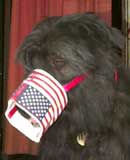
my Ringsport muzzle, more symbolic than truely bite preventing
(notice that the dog is able to pant because the circumference of the muzzle is loose.
notice that his tongue is visible, mouth open enough to pant.)
MUZZLE IT !when, why, and how to use a muzzle |
There can be advantages to teaching your dog to accept wearing a muzzle and to do so calmly and cheerfully. This article discusses the various types of muzzle and the situations in which they may be appropriate. The muzzle can be helpful in many situations that might be encountered in the course of living with dogs. The muzzle can be an essential tool to ensure safety when beginning behavior modification of behavior problems where there is potential for a bite. That behavior modification may be essential to saving the dog's life, enabling the dog to live with humans.
(the phrase "muzzle it !" comes from the classic TV show "All In The Family")
| SITE INDEX | BOUVIER | RESCUE | DOG CARE |
| PUPPY REARING | TRAINING | PROBLEMS | WORKING DOGS |
| BOOKS | VERSE | IMAGES | MISCELLANEOUS |
In the USA, we don't commonly use muzzles on our dogs, except perhaps at the vets or when dealing with an injured frightened dog. Otherwise, we tend to think of a muzzle as something exclusively for the truly vicious dog, you know, the one who probably ought to be put to sleep.
But there are so many more situations in which short term use of a muzzle can be beneficial for the humans and for the dog. That's the purpose of this article.
In continental Europe muzzles are commonly used and are part of every dog's life. Dogs are permitted to travel on all forms of public transport, but to do so they must be muzzled --- or at least the owner must have a muzzle with him and put it on the dog at the request of any other passenger. Thus most dogs are taught in their basic training to accept being muzzled. In France, the "heel off leash wearing a muzzle" is one of the basic obedience exercises in Ringsport, beginning at the introductory "BrevÍt" level and continuing through the most advanced level, Ring III. Below is the American Flag muzzle that I made to use for competition in Ringsport. This one fits so loosely that it would not prevent a bite delivered with front teeth , possibly even including punctures or slashes from the canines (fangs), though it would probably prevent a full mouthed bite with crushing from carnassals and molars.

What might be the advantages of accustoming your dog to wearing a muzzle and how can you accomplish this ? When might you want to use one ? What type of muzzle would be appropriate to various circumstances ? The purpose of this article is to answer these questions.
The advantage of training your dog to accept the muzzle and ignore its presence on his face is that this will remove 95% of the stress from wearing one. The circumstances in which you may later really need to use a muzzle include some which are inherently highly stressful, eg the seriously injured or frightened dog, so the dog already accustomed to being muzzled will be spared the added stress of this unfamiliar constraint. There are many other situations, discussed below, in which use of a muzzle can prevent problems or make the otherwise impossible possible and the otherwise untrainable amenable to training while minimizing risks to other dogs and people involved in the training.
(I probably should be ashamed to say that this was the method I used for Chelsea and Bones. But they were totally confident and totally trusted me. I just didn't have the imagination to use the more gradual method.)
To accustom your adolescent or adult dog to muzzles of various kinds, simply choose some convenient time in cool weather (ie cool enough that panting won't be an issue) when nothing else is going on and put a properly fitting muzzle of a type that allows the mouth to open several inches, upon the dog, making sure to tighten all straps sufficiently that the dog cannot scrape or pull the muzzle off. This will probably mean one hole tighter than you will use once the dog has totally accepted being muzzled. Be very sure that the dog cannot succeed in removing the muzzle. Use a few cords to anchor it to his collar if necessary. I would recommend using the nylon cloth type of muzzle as the most comfortable type and one which is fairly secure, ie hard for the dog to remove. Most dogs will initially be somewhat disturbed to find this thing on their face and will make some effort to get rid of it. (If using a wire basket type of muzzle, you may prefer to do this outdoors in your yard, as indoors he might try to scrape it against your furniture, causing damage to same. Also you should wear sturdy old pants rather than shorts or skirt, as the dog may try to scrape the muzzle off against your legs.) When efforts to rid himself of the muzzle fail, the dog will settle down and tolerate it. If possible, you should be passive and simply wait for this to happen. However if the dog does not seem to be settling down, then you might put him on a Sit-Stay (if he already knows this --- which he should!) and then enforce any breaks or fidgets just as you would for any other Sit-Stay. Wait until he has tolerated it without any removal efforts for about 5 minutes, then remove it. At the next session, go for 8 to 10 minutes. Next time only 5 minutes, then the next one go for 10 to 15 minutes. By this time the dog should be resigning himself to the muzzle from the moment it is placed on him. Once that stage is reached, you need merely do a 5 to 15 minute session once or twice a week for the next month and then once or twice a month. You may want to combine being muzzled with doing obedience or agility exercises, but not of course any retrieving exercises. If so, be very observant to ensure that the muzzle allows unrestricted panting.
This is absolutely the better way to do it for most dogs. It might take a little more time, but the stress on the dog is so much less.
To accustom a puppy or a less confident dog , the above procedure would be modified as follows. Before strapping the muzzle on, first do several lessons in which you entice the dog to insert his nose into the muzzle by offering a tasty tid bit which you hold with your fingers just inside the open nose end of the muzzle, ie with your hand in front of the nose end. Once the dog is thoroughly used to putting his face into the muzzle to get a treat, you can then fasten the straps. Once the straps have been fastened you can offer a few more treats, but only when the dog is not struggling. Quite frankly, at some point most dogs are going to try to remove the muzzle and you want this to happen so the dog finds out that he cannot succeed. Once they convince themselves that they cannot get rid of it, most dogs accept it.
The treats method can of course be used on any dog. Some of the best French Ring trainers advise this method, and of course they are working with totally confident and stable dogs.
Once your dog has accepted one type of muzzle , he will be far more ready to accept others, including those that are more restrictive. NEVER use a type that restricts the dog's mouth from opening for more than a very few minutes and ALWAYS remain present and alert and ready to remove the muzzle instantly if necessary for the dog's breathing or to let him vomit.
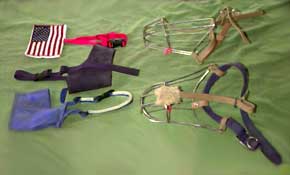
This is the one you see in first aid books, ie the strip of cloth or gauze (or leash or your scarf or necktie or belt) that you loop once or twice around the dog's snout , then tie beneath his chin, then loop around his neck and tie solidly. Or adhesive tape (which must be cut away). This is the type you will use when you find a dog that has been hit by a car, or similar emergency, and you have nothing else that fits. Every dog lover should know how to improvise this sort of muzzle. Once your own dog has accepted ordinary more comfortable muzzling, you can use him as your practice "victim". Prior practice can save you from a bad bite someday when you are trying to rescue some poor dog who is in pain and terrified. Be sure you know how to tie to "short snouted" modification, with the extra loop in the center of the forehead right between the eyes. Also be prepared to cut the muzzle off if the knot has become too tight to unfasten.
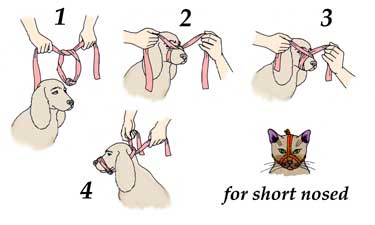
This is not usually thought of as a dog's item, but it admirably serves as an emergency muzzle. Just throw the loop about the dog's snout, with the little cross-connector under the chin. Pull the loop snug (as it slips through the cross-connector) and buckle the other loop of the eight around the dog's neck snugly. One size fits all (well, maybe not a really large headed dog). You can keep one of these in your glove compartment in your car so it's always there.
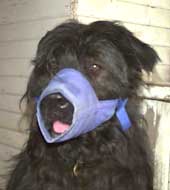
This one is sold under various names, eg "Quick Muzzle", "Mikki Muzzle", etc. This is the one your vet probably uses and that most groomers use when needed. (Update : a lot of vets now prefer to use a basket muzzle, as it is safer and less stressful for the dog while still being safe for the vet and helpers.) Very comfortable and very secure. Very easy to put on and take off. Unless you get it a couple of sizes larger than the size your vet would use, ie large enough to let jaws separate about two inches, this type is NOT appropriate for use for periods longer than a few minutes nor where panting may be needed, and is NOT for dogs left unsupervised. I strongly recommend that you own one to fit your dog and carry it with you in your traveling kit that you keep in the car. These can be found in most dog catalogs and cost $5 to $10. (Update : in 2003 they cost more like $20 at pet emporium stores.)
There is one called "Eazy Walker" that combines muzzle with halter function, as it has a ring under the chin for leash attachment. If you need to cope with walking a dog-aggressive dog that is unresponsive (or untrained to respect) to normal use of choke chain or pinch collar, or if you are physically unable to give adequate corrections with choke chain or pinch collar, then you might give this one a try. Get one large enough to allow free panting. (Found in the KV Vet Supply catalogue.) Update : use a basket muzzle instead : much safer in terms of panting and bite prevention.
Similar to the nylon cloth type but stiffer and more rugged. Probably less comfortable than the nylon cloth one. Much used in Europe. If the cone projects an inch or so beyond your dog's nose, then even if the circumference is a bit loose, letting the dog pant slightly, it will probably still prevent a bite.
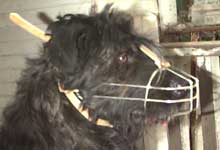
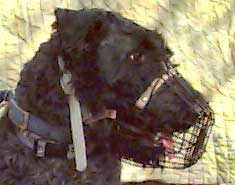
Some kind of basket muzzle is the very best type for use for extended periods of time, and it can be left on an unattended dog with reasonable safety. Airflow is excellent. If properly fitted, will allow full opening of dog's jaws for panting, water drinking, and for vomiting. Proper fit is with plenty of extra room above and below the snout and some extra room ahead of the tip of the snout. Inspect the design carefully : some of the wire types are incomplete in that there is a wire that should go all the way around the circumference of the snout , but that wire instead has a gap under the jaw, which can allow a vigorous opening of the jaws (as when lunging for a bite) to pop the wires apart and make a bite possible. This deficiency can be remedied by adding some wire across the gap, connecting the two parallel longitudinal wires so they cannot be forced apart. Also I recommend adding a strap that goes from center of top of snout up between the eyes to center of the top of the about the neck strap ; this makes it much harder for dog to pull muzzle foreword off the tip of the snout. If the dog is to be wearing the muzzle for many hours at a time, I suggest adding some padding on the inside of the muzzle where it rests on the top of the dog's snout to prevent abrasion.
A disadvantage of wire muzzles is that if a dog whaps into your flesh with one, you will probably get some bruises. The heavy plastic Greyhound / Whippet muzzles are probably better in this respect. The wire muzzles all have a tendency to get the wires bent under the impact that can occur during a dog fight. Also under strong impact, the wires may pop out of their welds, ie leaving you with a wire sticking out. A wire sticking out is a potential hazzard for making a puncture wound if rammed against flesh. In a dog fight, a wire poking out could conceivably puncture an opponent dog's eye. However the really high quality wire muzzles made by http://fordogtrainers.com are welded and very unlikely to have a wire pop out. Some of their models have above snout padding.
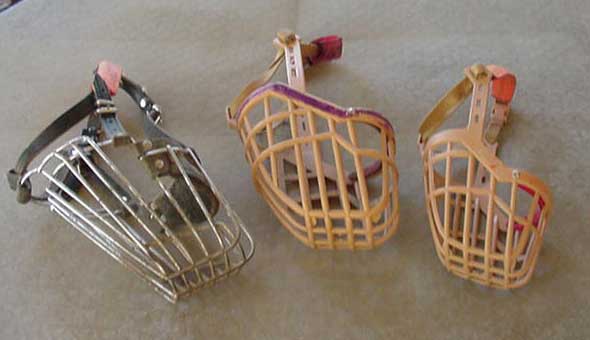
Unfortunately I do not have a brand name for the beige plastic muzzle, and even more unfortunately I've been told that the manufactuer may be ceasing to make them.
Also look into the Baskerville basket muzzle , made of tough rubber. An article at https://www.petexpertise.com/baskerville-ultra-dog-muzzle/ has a lot of information on this one. It's sold at PetCo and other large stores.
Greyhound / Whippet racing muzzles are another one in this category and may well be the very best choice for general use. They are designed for maximum airflow, as a racing dog needs all the air he can possibly get.. They are a very sturdy plastic with plastic coated straps. Unlike the other plastic muzzles, made of much lighter plastic, I think these are unlikely to break. A wide range of colors, in case that matters to you. The Greyhound Large size or the XL size may well fit most Bouviers. These are also available in Whippet sizes, which can also fit some terriers. Halemar looks to me like the best brand : <www.halemar.com/itmidx1.htm> . Current costs are from $10 to $15, which is less than that for the other basket muzzles. An anti-copraphagia attachment is available for a few dollars more. Replacement straps are available as well.
 "kennel" muzzle, blue | 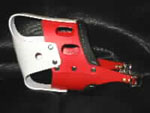 Halemar "racing" muzzle, red |
Since writing the above, I have had to recognize one potential failing of greyhound muzzles and any other muzzle (such as many Police muzzles) that is held on only by an over-the-head-and-behind-the ears strap. This strap can be rubbed by the dog against some object and thus be pulled forward and over the ears, thus allowing the muzzle to fall off the dog's snout. In Greyhound or Whippet races and in Police dog protection training, the dog is so focused single-mindedly on the lure or the decoy that it is not going to pause to rub the muzzle or it's straps against any object in the environment. But a dog wearing a muzzle at the dog park or on an off leash walk or at liberty in the house or yard might well do so and accidentally remove the muzzle. Now you suddenly have an unmuzzled dog and you may be in big trouble. Once a dog has learned to do this by one sucessful accident, he may be very quick to do it again and again. But you can modify the strapping so you can add an around-the-neck strap that is secured very snugly.
The muzzles that attach to an around-the-neck strap that goes around the throat , in addition to the over-the-ears strap just behind the dog's head, are much more secure.
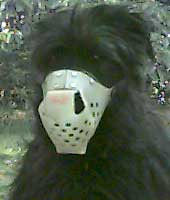
These are intended for maximum safety , ie bite prevention. Leather ones are very heavy and often reinforced with metal. "Jafco" brand (pictured here), made of plastic, is very effective and respected. This type of muzzle is NOT meant to be worn for more than a few minutes at a time if dog is being strenuously active. I would NOT leave on an unattended dog.
Do NOT use the (lightweight) plastic basket muzzles in any situation in which breakage of the muzzle could have disastrous consequences ! Do NOT use a damaged wire muzzle if a sticking out wire could cause injury. Always INSPECT a muzzle and its straps before use and be sure it is ADJUSTED onto the dog SECURELY enough that it cannot come off. Make sure to add an around-the-neck strap that will be adjusted tightly to any of the muzzles that come with only an over-the-head-behind-the-ears strap, especially if the dog might have oppertunity to rub the muzzle or its strap against anything and thus pull the muzzle off.
It's critical that the muzzle be sized so that the dog can open the mouth to pant or to vomit. It's also critical for most uses that the muzzle's straps (the over the ears strap and the center face strap) be adjusted so that the muzzle cannot be pulled off over the dog's nose. Be sure to do a pull-off test. Add a center of face strap , going from center of noseband, then between the eyes, to the center of the behind-ears strap, if needed. (The model for the photos below is Fox The Wicked Queensland.)
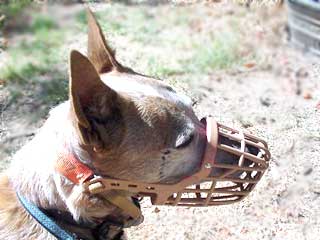 space below dog's mouth (now closed) allows panting |  doing the pull-off test (I am pulling hard) |
The exception to the "must allow panting" rule is the use of the tie-on muzzle for picking up the injured, terrifed and in pain, accident victim. If possible remove the tie-on once the dog is safely confined for transport to the veterinary ER. The other exception is use of a tight fitted cone by the vet, though many vets have gone over to using a basket muzzle as being just as safe for the handlers and much safer for the dog.
Because proper fit is so crucial, buy your dog's muzzle at a brick-and-mortar store, preferably one where the salespeople are knowledgeable. It's imperative to make sure you try the muzzle on the actual dog so that you buy a correct fit. (and if in doubt, go one size larger and adjust straps accordingly). If it would be too dangerous to bring that dog into the store, take the dog's snout length and snout depth with mouth wide open (grasping a big toy is one way to get that measurment) and then buy two sizes with intent to return the one that turns out to be wrong size. Buying at a brick-and-mortar store may seem a bit less convenient and a bit more expensive than buying on line, but guessing wrong and buying the wrong size on line is much more inconvenient and expensive if the result is your dog over-heating because of inadequate panting space or if the fit is so bad as to enable a bite. Of course once you have bought one muzzle of the right size, you might want a second one either as spare for this dog or for a second dog who that same size (proven by try-on) is correct.
Tied on gauze or leash or your belt or whatever you can find to use. Unless you are in a situation in which the dangers of being hit by traffic are more serious than the dangers of being bitten by the dog, DO take time to muzzle the dog. A dog who is terrified or in great pain is HIGHLY LIKELY TO BITE anyone who tries to help. Even your own dog is likely to bite you under these circumstances ! (If you don't have chance to muzzle the dog, eg because of traffic risks, at least throw a jacket or blanket over his head if you can do so. But always remember that a car is much more deadly than a dog's bite !.)
Use for any procedure your dog may resent or find startling or frightening or painful. Usually the nylon cloth conical type. Your vet will love you for having the consideration to ensure her safety and she will be able to do much better work if she does not have to worry about getting bitten.
Update 2020 : a lot of vets now prefer the basket type of muzzle.
If you don't know the dog well (a new intake) or if you even slightly suspect that this dog might bite under stress, DO tell your vet and DO muzzle the dog. Vets really appreciate clients who take precautions for the vet's safety (and staff safety). Vets really hate it when an owner fails to tell them that they already know the dog might bite because the dog has bitten before (at another vet clinic where you are now no longer welcome). Likewise vets appreciate it if a dog who might be dog aggressive or cat aggressive in the waiting room is muzzled, as well as being (of course) on leash.
Use a muzzle to ensure safety of the cat in an inherrently unpredictable situation and to eliminate owner's anxiety allowing owner to behave in calm and thinking manner. Wire basket or Greyhound is probably best type to use. Dog's owner should be prepared to either correct dog for any attempted aggression or else to simply interrupt the behavior and call the dog away from the cat to be rewarded. (I'd probably correct a more aggressive or more intense dog and simply distract and call back a less aggressive and less intense dog.)
For temporary cohabitation of dog and cat when dog might be cat-aggressive or is known to be cat aggressive, I would consider a muzzle to be insufficiently safe for both parties, especially without continuous vigilant human supervision. Far better to keep them separated by a securely latched door or other impenetrable barrier when such supervision is not practical. Use the muzzle when you are able to supervise and wnat to work on training the dog to be more obedient and less aggressive in the cat's presence.
You may want to use a muzzle for safety (of dogs and of humans present) and eliminate handler anxiety. Muzzle both. Wire basket, Greyhound, or nylon/leather conical. Once dogs have established dominance rank, the muzzles can usually be removed.
Temporary cohabitation of incompatible dogs, either where they cannot be separated or where there is risk they will accidentally get together. One or both dogs would be muzzled whenever they are together. (I have personally used this for long term cohabitation over many months with one dog who unpredictably & wantonly attacked another. Only the aggressor was muzzled. He was crated at night so muzzle could be removed to prevent pressure sores. ) I would much rather keep such dogs completely separated until whichever dog you like less or whichever is more placeable can be re-homed into a home where it is the only dog or only dog of its sex.
Very few herding teachers or trainers ever use a muzzle. However for nervous handlers and valuable or cherished livestock, or for a dog whom one believes or fears might be highly aggressive to the stock and have the jaw power to do serious injury, use of a muzzle for the first introduction can make good sense. Use of a muzzle protects the stock and eliminates handler's anxiety, so can think calmly and speak in a calm voice. (An excited , angry, or shrieking voice will greatly increase the dog's excitement and probable aggression towards the livestock.) Usually the muzzle can come off after first few minutes or first few lessons. If after a few lessons you are still unwilling to remove the muzzle, then it is time to re-evaluate the dog's suitability for herding : ie this dog is probably not going to be a reliable herder.
Note however that most serious injuries to sheep do not result from bites but rather from the sheep being so frightened that they crash into a fence. If a sheep hits a firm fencepost head on and forcefully, the sheep can suffer a fatal brain or spinal cord injury. I've personally witnessed several such fatalities over the years, but never yet a bite causing a fatality. A muzzled dog can be just as terrifying to sheep as an unmuzzled one and so can cause fence crashing fatalities.
For ducks of course a bite can be fatal ; indeed, a bite is quite likely to be fatal.
With cattle, we are not so worried about a bite, but we are more worried about the dog being seriously injured by a kick or by bovine horns, and we should also be concerned about cattle damaging fences by crashing through them. A muzzle will not do much to prevent any of these mishaps. Almost all herding trainers want a dog very well started on sheep and very obedient to basic herding commands before the dog every is introduced to cattle, and those introductory cattle should be very well dog-broke. There are plenty of dogs who should never be put on cattle.
Poop eating can be prevented by a plastic or other shield across the front of the plastic or wire basket type of muzzle.. (Frankly I would instead recommend trying various nutritional supplement approaches, plus keeping yard poop-scooped frequently.) I've seen muzzles designed for prevention of copraphagia in Brittish horse magazines. Some of the Greyhound suppliers sell an add-on insert for this purpose. You can turn any basket muzzle into an anti-copraphagia muzzle by cutting a piece of plastic (eg from a plastic one gallon jug) and attaching it to the front of the muzzle.
By "sidewalk surfing" I mean any situation in which there are or might be objects or food on the ground which the dog might pick up and eat which could be harmful to the dog. In urban areas, the sidewalks can be full of food that is spoiled (can cause digestive upset, diarehha, etc) or that contains chicken bones (can splinter and cause intestinal perforation resulting in peritonitis, potentially fatal) or otherwise undesirable. In rural areas, farmworkers may leave bits of food behind. But for rural areas, the greater concern is rodents that might have been poisoned with bait that can have second-hand kill. Most of these baits are anti-coagulents, but some are zinc based which is even more dangerous. Dead birds are probably also not good snacks for your dog. Horse poop and cattle poop won't harm your dog, though you will probably want to avoid letting the dog kiss your face for a while afterwards.
This is probably not a method that would appeal to you for keeping your guest-friendly dog from helping himself to food that guests leave unguarded in positions too easily reached by the dog. Yes, you could do it, but it really prevents your guests from wanting to pet the dog. However if you know that a guest might try to remove such "stolen" food from the dog's mouth and that the dog might bite to defend the food, then you really must either muzzle the dog or exclude the dog from the party, eg by putting the dog in a crate or closed bedroom. (I favor the exclusion method in this case.)
I deal with the topic of "surfing" at greater length in Dogs "Stealing" Food, about dogs taking food from your countertops, garbage, tables, sidewalks.
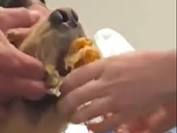
Occasional lessons in a muzzle are used to encourage full body "tackle" by dog, and to use variety of "bad guys" (eg those who are not trained or willing to take a bite on a sleeve or a suit) and in situations where a bite can't be taken safely (eg bad guy lying down). Here the muzzle is actually being used to increase aggression by temporarily frustrating the dog's strong desire to bite in a situation that strongly provokes that desire and with handler strongly encouraging aggression.
I've personally been on the receiving end of such a muzzled hit, teaching some police dogs that a small woman might still be a serious threat and thus be a proper target. I was assaulting the officer with a very realistic looking but totally harmless plastic "collapsing" knife (the shiny plastic blade retreated into the handle under a few ounces of pressure). I found this to be fun, but it was also a serious contribution to keeping the officer safe out on the streets.
DO NOT TRY ANY FORM OF TRAINING OR REHABILITATION WITH A BITING DOG WITHOUT PROFESSIONAL HELP !!
A muzzle may be ESSENTIAL for evaluation of behavior problem in a potentially dangerous dog by trainer. This allows trainer and owner to "set up" situation that will trigger the worst the dog has to offer so trainer can see it and try an appropriate treatment protocol. This is especially appropriate where the triggering situation involves innocent and/or unskilled participants, eg dog aggressive against children, other dogs, cats.
A muzzle may be ESSENTIAL while initiating rehabilitation training of a potentially dangerous dog, ie dog-aggressive or people aggressive. Sometimes this is the only way training can be initiated when the dog is truly dangerous (high aggression plus lots of physical power) without risking serious injury to someone .
Please note that any attempted evaluation and rehabilitation of a dog who is believed to have this kind of dangerous potential should ONLY be done with the supervision and participation of a highly skilled professional behaviorist (Veterinary Behaviorist or Applied Animal Behaviorist) who has tons of experience with aggressive dogs. The decision as to the method to be used should be made by the behaviorist. In other words, though I describe some proceedures in the next few paragraphs, DON'T try any of these on your own without professional help.
The muzzle can be helpful in beginning of any of the "non-confrontaional" programs, such as "working for a living" or "nothing in life is free", for establishment of human leadership over a dog who has usurped the Alpha position or had it abdicated to him by an unassertive owner. Since in many cases the owner is already feeling intimidated by the dog, the use of a muzzle may be the only way the owner can feel enough confidence to begin the program.
Likewise a muzzle may allow the beginnings of a desensitization or desensitization plus counter-conditioning program designed to rehabilitate a potential fear-biter dog. Many biting dogs are doing so out of fearfulness and lack of self confidence. A lot of very dangerous biters are produced by the situation of the dog who lacks self confidence but who finds himself unwillingly placed in a position of leadership because the humans have abdicated their proper role as pack-leader and guardian. A muzzle may enable the owners to begin the essential program of establishing themselves as leaders and the equally essential program of desensitizing the dog to each of its identifiable fear-producing stimuli and situations.
For example, a muzzle can be needed at the start of a rehabilitation program for a dog who will not permit some part or parts of his body to be touched. In such cases it is sometimes not clear how much of the problem is fear (lack of trust in people) and how much is dominence (lack of respect for the handler) but taking away the ability to bite while gently touching the dog until the dog learns to tolorate and enjoy such touch can be essential to working with such a dog. (I've done this with a couple of dogs who threatened to bite if one tried to touch their feet and eventually got them to enjoy daily foot massages.)
IF the problem is one that calls for set-up and correction, with jaws disabled by the muzzle the initial phase of set-up and correction can be done safely and may make an impression on the dog. Set ups and corrections would be for the dog whose aggression is coming from a high degree of self confidence combined with a high degree of dominence; it is NOT for the dog whose problems have any element of FEAR, and many behaviorists believe that most aggressive dogs have underlying fear issues. If some period of training with muzzle brings about enough apparent improvement in dog's attitude and behavior, then continued training may be attempted without muzzle. (This is not guaranteed to work. When muzzle is removed, dog may or may not retain the apparently improved attitude and behavior; he may even be worse, ie the aggression enhanced by frustration. If dog remains dangerous, he should then be euthanized with owner clear in conscience, knowing that genuine rehabilitation effort was made.)
The muzzle may also be needed for the initial phases of other behavior modification programs in which there is concern that the dog might bite. For example, it might be used for the initial phases of rehabilitating a dog who shows jealously possessive resource-guarding of one human against another or others generally.
Please note that for dogs with dog to person or dog to dog aggression problems the ultimate outcome of rehabilitation attempts may be successful rehabilitation , enough so to allow the dog to live in reasonable safety with a very knowledgeable and vigilant handler, or it may be failure and the acknowledgement that this dog really does belong in "the great kennel in the sky", ie that this dog really should be put to sleep, euthanized, killed. But at least using a muzzle for the early phases of the rehabilitation attempt will allow you to come closer to a decision without getting anyone, yourself included, seriously injured.
DO NOT TRY ANY FORM OF TRAINING OR REHABILITATION WITH A BITING DOG WITHOUT PROFESSIONAL HELP !!
Remember : a muzzle TAKES THE WORRY OUT OF BEING CLOSE !!!
Thanks to my patient muzzle model, Shady. (the better basket muzzle is modeled by Max.). FoxTheWickedQueensland is modeling the correct fit and pull-off testing photos.
Related topics :
| site author Pam Green | copyright 2003 |
| created 1955, added to site 7/12/03 | revised 9/03/07, 8/17/2020 |
| return to top of page | return to Site Index |